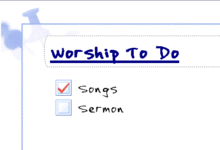Complexifying the Liturgy
February 25, 2007
 As we plan weekly worship here at Fuller Seminary, the worship interns and I have been talking quite a bit lately about three persistent and related problems.
As we plan weekly worship here at Fuller Seminary, the worship interns and I have been talking quite a bit lately about three persistent and related problems.
The first problem is theologically inspired boredom: we are growing weary of planning and leading the same twenty minutes of “opening exercises” every week. The dominant feature of our pre-sermon worship time is a significant chunk of music interspersed with words of welcome and perhaps a prayer or two. In the past months we’ve worked hard at intentionally selecting congregational songs that have cultural breadth, theological depth, and liturgical clarity. Still, the logistics of the service (including the architectural shape of our space) leave us with a default organizational ordo with which we are increasingly uncomfortable. It is an order that feels not blessedly simple but distressingly simplistic: songs (led by a group from the right hand side), followed by a sermon (preached by a professor from the left hand side).
The other problems we’re struggling with are thematic coherence and sacramental expectation.
***
The seminary professors who are asked to preach each week are notoriously tardy in selecting the Scripture and theme for their sermons. Thus, the chapel staff is left to plan the preparatory worship time (singing) with no clue about what we’re preparing for. This is problematic because for some in our worshiping community, the sermon is perceived as the primary locus for encountering God. The musicians, then, feel this burden: the music we sing must serve that encounter or risk total irrelevance. Or something even worse.
For others in our community, music itself has taken on sacramental qualities. For these folks the primary means by which the gracious promises of God in Jesus Christ are made tangible and real is in congregational song. Like it or not, that is a lot of freight to haul with two guitars and three chords. We are keenly feeling the need to find a better way to manage expectations for meeting God in worship.
In response, we have begun to experiment with an alternative ordo for our weekly gatherings. It is an arrangement that better reflects the history of campus-based worship, and one for which sacramental expectations are spread out over a broader palate of liturgical actions. What we are considering, essentially, is abandoning the songs/sermon ordo in favor of a more complex, though no less mnemonic pattern. Rooted in the structure of daily prayer followed for centuries by the precursors of academics, the medieval monks, it has four parts rather than two: praise/psalm/proclamation/prayer.
Services begin with an acknowledgment of who God is, and the natural response to that knowledge, praise. Of course, praise can be fittingly expressed in a number of ways; music is just one of many options. The psalm and proclamation follow. In them we are seeking neither scriptural ground for our expressions of personal piety, nor applicatory fodder for individual exercises of Christ-like devotion. Scripture isn’t a devotional McNugget. Instead, we hope as a community in the Word to receive a God’s-eye view of universal truth, a horizon-broadening articulation of the world the way it really is: broadly broken, desperately beloved, and radically redeemed. Finally, we focus on prayer as the place where God and God’s people speak to one other, heart to heart. We do so, as far as we are able, without preconditions and without pretense.
What is so liberating about this structure is that music, along with every other art form, becomes neither absolutely central nor peripheral to worship’s purpose. In our communal worship , art is not inherent but instrumental. That is to say, both the band and the liturgists retain their positions of leadership throughout the entire service. Music—and for that matter, dance and graphic art and drama and so on—are freed to serve the liturgical purposes of each component part of the service: praise, psalm,proclamation , or prayer. Songs of praise may be fitting, along with antiphonal psalms, scriptural hymns, or musical prayers. Or none of the above. Or all. Furthermore, the sacramental burden is shared by all the portions of the service; any portion, in its own way, can help worshipers to encounter the living and triune God.
* * * * * * *
Comments